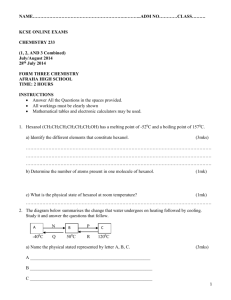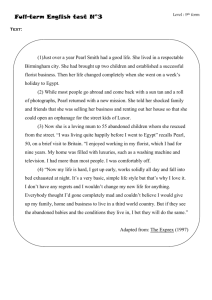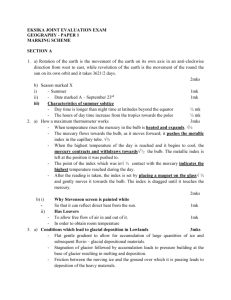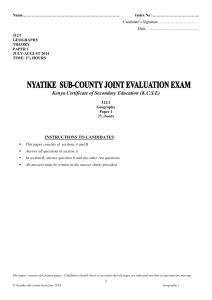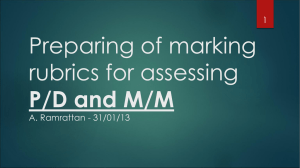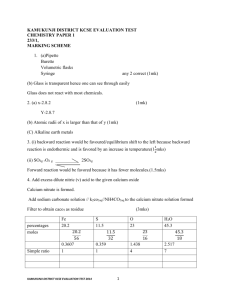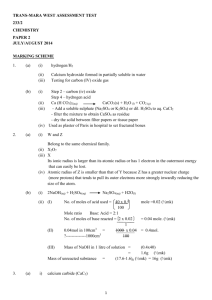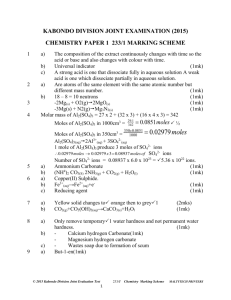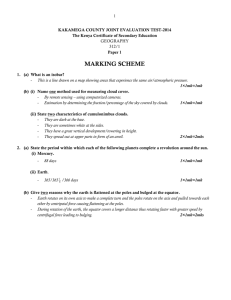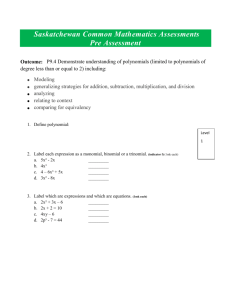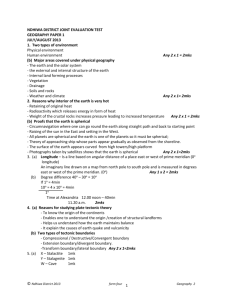TRANS-MARA WEST DISTRICT EXAM
advertisement
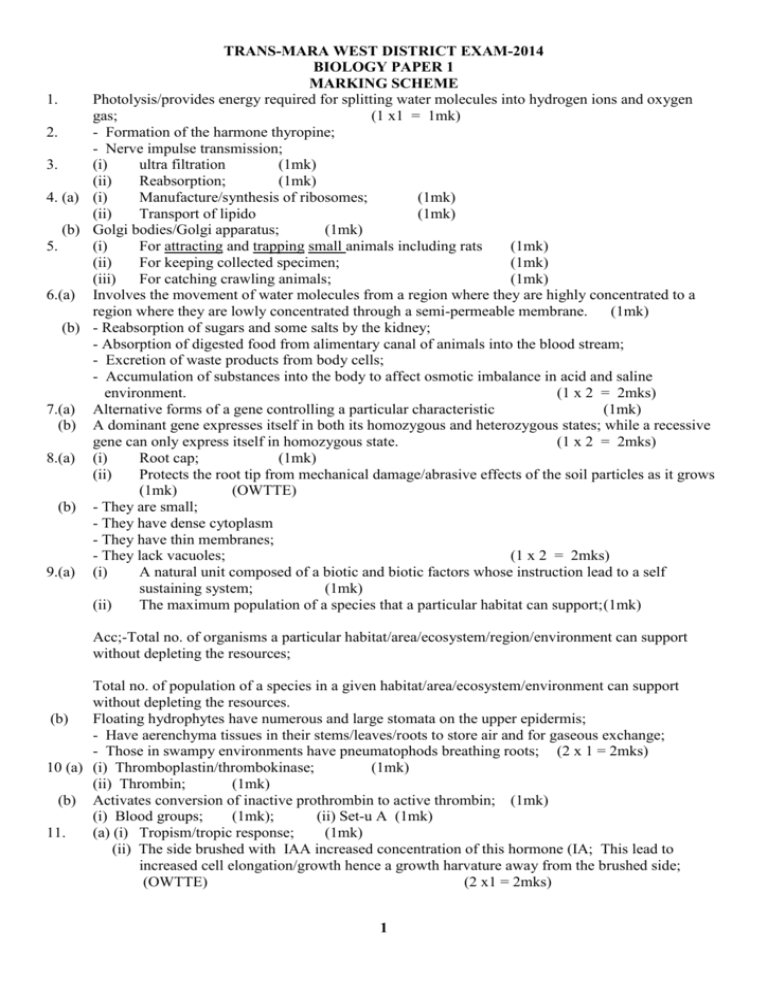
TRANS-MARA WEST DISTRICT EXAM-2014 BIOLOGY PAPER 1 MARKING SCHEME 1. Photolysis/provides energy required for splitting water molecules into hydrogen ions and oxygen gas; (1 x1 = 1mk) 2. - Formation of the harmone thyropine; - Nerve impulse transmission; 3. (i) ultra filtration (1mk) (ii) Reabsorption; (1mk) 4. (a) (i) Manufacture/synthesis of ribosomes; (1mk) (ii) Transport of lipido (1mk) (b) Golgi bodies/Golgi apparatus; (1mk) 5. (i) For attracting and trapping small animals including rats (1mk) (ii) For keeping collected specimen; (1mk) (iii) For catching crawling animals; (1mk) 6.(a) Involves the movement of water molecules from a region where they are highly concentrated to a region where they are lowly concentrated through a semi-permeable membrane. (1mk) (b) - Reabsorption of sugars and some salts by the kidney; - Absorption of digested food from alimentary canal of animals into the blood stream; - Excretion of waste products from body cells; - Accumulation of substances into the body to affect osmotic imbalance in acid and saline environment. (1 x 2 = 2mks) 7.(a) Alternative forms of a gene controlling a particular characteristic (1mk) (b) A dominant gene expresses itself in both its homozygous and heterozygous states; while a recessive gene can only express itself in homozygous state. (1 x 2 = 2mks) 8.(a) (i) Root cap; (1mk) (ii) Protects the root tip from mechanical damage/abrasive effects of the soil particles as it grows (1mk) (OWTTE) (b) - They are small; - They have dense cytoplasm - They have thin membranes; - They lack vacuoles; (1 x 2 = 2mks) 9.(a) (i) A natural unit composed of a biotic and biotic factors whose instruction lead to a self sustaining system; (1mk) (ii) The maximum population of a species that a particular habitat can support; (1mk) Acc;-Total no. of organisms a particular habitat/area/ecosystem/region/environment can support without depleting the resources; Total no. of population of a species in a given habitat/area/ecosystem/environment can support without depleting the resources. (b) Floating hydrophytes have numerous and large stomata on the upper epidermis; - Have aerenchyma tissues in their stems/leaves/roots to store air and for gaseous exchange; - Those in swampy environments have pneumatophods breathing roots; (2 x 1 = 2mks) 10 (a) (i) Thromboplastin/thrombokinase; (1mk) (ii) Thrombin; (1mk) (b) Activates conversion of inactive prothrombin to active thrombin; (1mk) (i) Blood groups; (1mk); (ii) Set-u A (1mk) 11. (a) (i) Tropism/tropic response; (1mk) (ii) The side brushed with IAA increased concentration of this hormone (IA; This lead to increased cell elongation/growth hence a growth harvature away from the brushed side; (OWTTE) (2 x1 = 2mks) 1 12. (a) Deamination; (b) (i) Glycogen; (ii) Glucose; (1mk) (1mk) (1mk) 13.(a) Homologous structures have a similar embryonic origin but modified to perform different function; Analogous structures have different embryonic origin but modified to perform similar function; (2 x 1 = 2mks) (b) That a phenotypically acquired characteristics can be transmitted to the offspring by their parents; (1mk) 14 (a) - Open system - Closed system - Blood flows at low pressure - Blood flows at high pressure - Blood flows in haemowel/sinuses - Blood is confined in vessels/closed vessels/body body cavity/coacom /directly in vessels; contact with cells. - Blood lacks pigments for - Blood has pigment for transport of O2 and Co2 transport of O2 and Co2 (2 x 1 = 2mks) (b) - Can contract continuously without fatigue; - Their contraction is stated by the muscles themselves (and not by the nerves/myogemic); (2 x 1 = 2mks) 15.(a) Vasodilation/blood flows on the surface; - Hair lies on the skin/hair lies flat on the skin; - Metabolic rate decreases; - Sweating; (2 x 1 = 2mks) (b) It is long to increase surface area for reabsorption of water. - It is lined with a network of capillaries to enhance reabsorption of water; - It is u-shaped to bring about counter current multiplier effect/to concentrate salts in the medulla to bring about reabsorption of water; (2 x1 = 2mks) 16.(a) leads to the formation of larval utricle; (1mk) (b) (i) Growth rate in rapid/fast/high and shed cuticle several times hence feed alot to have (desired) energy; (1mk) (ii) - Cells elongate before the cuticle harden; - Some cell division take place; (1 x 1 = 1mk) 17. - Oxygen depletion due to excessive growth of aquatic plants leading to suffocation and death of aquatic animals; - Entrophication hinder light penetration affecting photosynthesis in submerged hydrophytes; - Cause water surface blockage affecting navigation/fishing. (3 x 1 = 3mks) 18. - Having sexual (unprotected) intercourse with an infected person; - Blood transfusion with infected blood; - From infected mother to child during birth; - Use of unsterilized, infected surgical instruments; - Sharing cutting/piercing instruments with infected people; (3 1 x = 3mks) 19. - Arthropods are large multicellular organisms; - Arthropods have jointed appendages; - Arthropods body is covered by an exoskeleton; - Arthropods have segmented bodies; - Arthropods exhibited sexual reproduction with an internal fertilization. (3 x 1 = 3mks) 20.(a) (i) Offers a large surface area for muscle attachment (1mk) (ii) Humerus; (1mk) Rej: Humerous or other wrong spellings for humerus (b) - Cellulose - Colenchyma tissue. - Selerenchyma tissue. 2 - lignified xylem and tracheids; 21.(a) Anaerobic respiration (1mk) Rej: Respiration alone (b) (i) To expel all the dissolved oxygen; (ii) 22. 23. Glucose Enzyme Acc C6H12O6 (2 x 1 = 2mks) (1mk) carbon (IV) oxide + Ethanol + Energy 2CO2 + 2C2 H5 OH + ATP; - Natural active immunity; - Artificial active immunity; (1mk) (2 x 1 = 2mks) (i) Funnel shaped to collect and concentrate sound waves into the external auditory meatus; - In some animals its large and when flapped creates air currents lining about cooling effect to the animals; (1 x 1 = 1mk) (ii) Its thin and flexible to enable transformation of sound waves into vibrations (1mk) (iii) It’s coiled to offer a large surface area for the attachment of the sensory cells. - Has numerous sensory cells to perceive sound vibrations. - Has thin membrane that vibrates more increasing the intensity of sound vibrations; - It’s filled with a fluid to enhance transmission of sound waves in it. (1 x 1 = 1mk) 24.(a) Cerebrum; (1mk) (b) Nourishes the brain cells/supplies nutrients/removes metabolic wastes from brain cells. - Acts as a shock absorbs to the CNS (2 x 1 = 2mks) 25. - Nasal cavity has hairs and mucus that trap solid particles and dust; - Nasal cavity is well supplied with blood that warms and moistens incoming air. - Has olfactory cells that are sensitive to smell; (2 x 1 = 2mks) 26. (a) Budding; (1mk) (b) (i) Production of the male reproductive cell/gamete/sperm; - Production of androgens/male hormones. (1 x1 = 1mk) (ii) Fertilization takes place here/where fertilization occurs; - Passage of the female gamete/fertilized ovum to the uterus. (1 x1 = 1mk) (iii) passage of urine/sperms/semen; (1mk). 3
